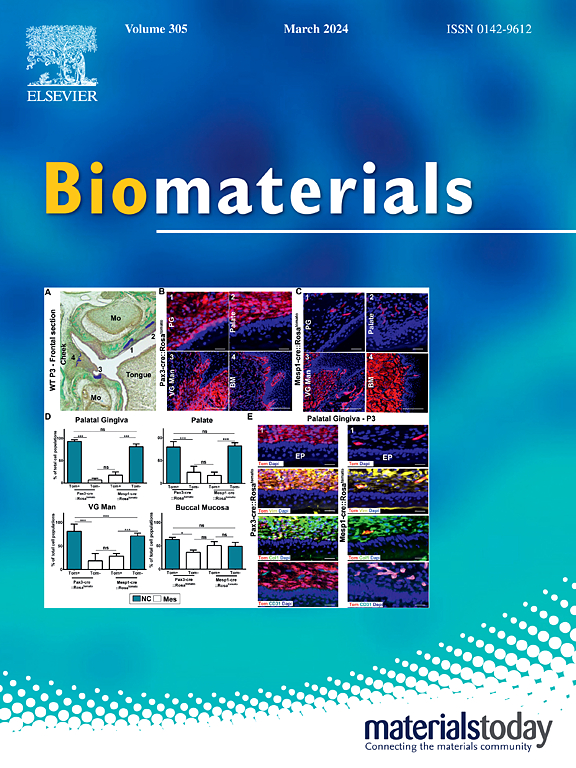细胞外基质糖基化在体外衰老神经血管模型中调控脑老化和神经变性
IF 12.9
1区 医学
Q1 ENGINEERING, BIOMEDICAL
引用次数: 0
摘要
随着预期寿命的持续增长,应对老龄化和与年龄有关的疾病对于保持健康的生活方式至关重要。随着年龄的增长,晚期糖基化终产物(AGEs)在脑组织中积累,在老年人和阿尔茨海默病患者的大脑中与β淀粉样蛋白和tau蛋白共定位。然而,AGE水平升高、衰老和神经退行性变之间的联系尚不清楚。为了探索AGEs对大脑的影响及其机制,我们开发了一个神经血管(NV)模型,该模型通过整合age锚定矩阵来反映老年大脑的特征。在age合并条件下,我们观察到脑内皮功能障碍和小胶质细胞激活,导致神经炎症和神经变性增加。值得注意的是,我们发现,在老年NV模型中,靶向AGE及其受体可以通过组蛋白修饰酶KMT2A减轻AGE介导的神经功能障碍。我们在NV模型中的发现与在老年和阿尔茨海默病小鼠模型中观察到的结果一致。这种衰老的大脑模型为阐明大脑衰老的表观遗传机制提供了一个有价值的平台,并为衰老相关的大脑疾病提供了新的抗衰老策略。本文章由计算机程序翻译,如有差异,请以英文原文为准。
Extracellular matrix glycation epigenetically regulates brain aging and neurodegeneration in the in vitro aged neurovascular model
As life expectancy continues to rise, addressing aging and age-related diseases becomes crucial for maintaining a healthy lifestyle. Advanced glycation end-products (AGEs) accumulate in brain tissue as we age, co-localizing with amyloid β and tau in the brains of elderly and Alzheimer's disease patients. However, the link between increased AGE levels, aging, and neurodegeneration remains unclear. To explore the effect and mechanism of AGEs on the brain, we developed a neurovascular (NV) model that reflects features of an aged brain by integrating an AGE-anchored matrix. Under AGE-incorporated conditions, we observed brain endothelial dysfunction and microglial activation, leading to increased neuroinflammation and neurodegeneration. Notably, we discovered that targeting AGE and its receptor could attenuate AGE-mediated neurodysfunction through the histone-modifying enzyme, KMT2A, in neurons within an aged NV model. Our findings in the NV model align with those observed in aged and Alzheimer's disease mouse models. This aged brain model offers a valuable platform for elucidating the epigenetic mechanisms of brain aging and provides insights into novel anti-aging strategies for age-associated brain disorders.
求助全文
通过发布文献求助,成功后即可免费获取论文全文。
去求助
来源期刊

Biomaterials
工程技术-材料科学:生物材料
CiteScore
26.00
自引率
2.90%
发文量
565
审稿时长
46 days
期刊介绍:
Biomaterials is an international journal covering the science and clinical application of biomaterials. A biomaterial is now defined as a substance that has been engineered to take a form which, alone or as part of a complex system, is used to direct, by control of interactions with components of living systems, the course of any therapeutic or diagnostic procedure. It is the aim of the journal to provide a peer-reviewed forum for the publication of original papers and authoritative review and opinion papers dealing with the most important issues facing the use of biomaterials in clinical practice. The scope of the journal covers the wide range of physical, biological and chemical sciences that underpin the design of biomaterials and the clinical disciplines in which they are used. These sciences include polymer synthesis and characterization, drug and gene vector design, the biology of the host response, immunology and toxicology and self assembly at the nanoscale. Clinical applications include the therapies of medical technology and regenerative medicine in all clinical disciplines, and diagnostic systems that reply on innovative contrast and sensing agents. The journal is relevant to areas such as cancer diagnosis and therapy, implantable devices, drug delivery systems, gene vectors, bionanotechnology and tissue engineering.
 求助内容:
求助内容: 应助结果提醒方式:
应助结果提醒方式:


